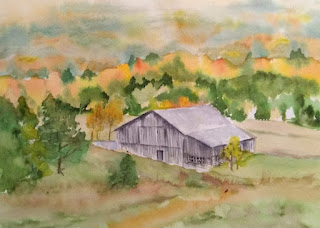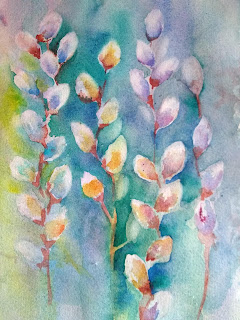Monday, November 30, 2020
PLAYING AROUND
Sunday, November 22, 2020
CHRISTMAS SNOWGLOBES
CREATING A DISTANT LOOKING BACKGROUND
FROM THIS:

Thursday, November 19, 2020
Loose Pussywillows
I found a picture of pussywillows in Jean Haines' book, Atmospheric Flowers in Watercolor, page 49.
There were no instructions how to do it, but I remembered a class I took from Sandy Maudlin years ago, so here is how I would paint this picture.
First, using a large brush, wet the paper and make a wash with several colors. I did mine vertical, but it doesn't have to be. I used ultramarine, pthalo blue, quin gold, magenta, and lemon yellow. TIP: try to use non-staining colors for your first try. (don't use pthalo or carbazole violet). You will be able to lift out white much more easily.
 .
. In Jean Haines' version, there are more dark vertical streaks of green and burnt scarlet at the bottom.
OK, couldn't resist...added some stems and dark green at bottom. Did I mess it up?
Thursday, November 5, 2020
MAKING YOUR OWN PAINT
Years ago an art teacher friend visited Roussilon, France, which is known for its ochres. The entire village is painted only in ochre shades. She returned home with some ochre pigments from Roussilon, and together we figured out how to turn them into watercolor paints.
Your watercolor paints are generally made of 3 things: a pigment; a binder (traditionally gum arabic, but QoR has its own); and something to make paint flow, such as ox gall. Other possible additives are honey and glycerin.
There are no set recipes, but in general the ratio of binder to pigment is 2 to 1; some say 1 to 1. You may have to experiment.
Pictured above are the simple supplies needed: Left to right are: ox gall, gum arabic, glass muller, pigment, half-pans (or other containers to put paint in), palette knife, and glass dish. I used premixed gum arabic, but there is a video linked below that explains how to mix your own from the powder. (much cheaper)
To make a small amount of paint, pour a T. of gum arabic, a drop of oxgall, and a drop of honey, if you want it, onto a glass plate. Mix well with your palette knife. Add a T. of powder pigment and mix together. If it seems too thin, add more pigment, a bit at a time.
When it seems to be the right consistency, use the glass muller to grind and blend the mixture until you don't see any more granules.
Scoop off the plate with a palette knife and into small containers. Allow to dry for a few days.
The glass plate should be of sturdy quality, such as the glass in a microwave. I don't have a muller (because of cost and because I don't do this often), but I use a glass that is perfectly flat on the bottom.
Below are short videos describing the process.
From Owens art--about 11 minutes. Simplest explanation with simple tools.
https://www.youtube.com/watch?v=OdP2xSWHvRw
Arleebean explains how to make your own binder (using ground powdered gum arabic)
https://www.youtube.com/watch?v=x_779MFFtF0
Oto Kano describes paint making process with more professional supplies
https://www.youtube.com/watch?v=WIdVblDIRWM
Below are the 4 shades of ochres I was able to make from my pigments.
FINISHING TOUCHES ON STARFISH
MORE BUBBLES?
I was so fascinated with the idea of using bubbles to create sea foam, that I added some more. First I tried Jean Haines way, applying soapy bubbles with a spoon onto an area and dabbing wc paint on top of them gently. Then I tried a bubble paint recipe using white paint, about a teaspoon of liquid dish soap, and a cup of water. I blew through a straw to make it bubble a lot. Then I scooped out the white/paint bubbles on top of dark areas. I really loved the effect.
You really need to be patient with this. There is no rushing, and it needs to dry naturally to be effective.
Below are some close ups of the bubbles after they are dried.





























